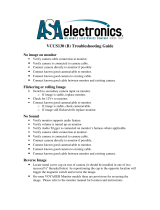
To check the back focus of a B4 lens:
1 Place a focus test chart, or a flat white item with good high contrast detail, approximately
seventy feet, or as far away as possible, from the camera.
2 Set the iris on the lens wide open and compensate for exposure by using the built in NDs
if you need to. You’ll want a shallow depth of field so you can exaggerate any focus issues.
3 Zoom into the chart and set focus.
4 Now zoom out. If you reach maximum wide and the focus remains sharp, then your back
focus is correct and you don’t need to make any adjustments.
However, if you zoomed out and the chart drifted out of focus, the back focus is incorrect.
Zoom all the way out and adjust the back focus ring on the rear of the lens close to the
mount. The back focus ring typically has a twist knob used to loosen and tighten. Simply
loosen the twist knob and rotate the ring until your chart is in focus.
5 Now zoom in and out slowly and check if your chart remains in focus all the way
through the zoom.
6 Repeat steps 4 and 5, zooming in and out and making adjustments to the back focus ring.
If your lens holds focus all the way through the zoom range your back focus is now set correctly.
Setting back focus on Fuji LA16x8 BRM lenses
The process of setting back focus on a Fuji LA16x8 BRM lens is slightly different. Instead of an external
back focus ring this lens sets back focus electronically using a button underneath the hand grip.
To set back focus on a Fuji LA16x8 BRM lens:
1 Place a focus test chart, or a flat white item with good high contrast detail, approximately
seventy feet, or as far away as possible, from the camera.
2 Set the zoom switch underneath the lens handgrip to ‘servo’.
3 Locate the ‘F.f.’ button next to the zoom switch. Press and hold the ‘F.f.’ button
for 5seconds. The indicator LED on top of the zoom rocker will flash red.
4 The lens will automatically zoom in. Set focus using the focus ring. It’s important to note
that if you have Blackmagic Focus Demand attached you will need to unplug it from your
camera to adjust the physical focus ring or adjust the focus using the focus demand for
this step and step 5.
5 Press the ‘F.f.’ button again and the lens will automatically zoom out. Set focus using
the focus ring.
6 Press the ‘F.f.’ button to confirm the settings. The top indicator LED will flash red.
The electronic back focus on your Fuji LA16x8 BRM lens is now set.
7 Now zoom in and out slowly and check if your chart remains in focus all the way
through the zoom.
8 If your lens holds focus all the way through the zoom range your back focus is now
set correctly. If you need to make further adjustments, repeat steps 3 to 6.
TIP As temperature changes and wear over time can have subtle effects on the back
focus, it’s worth regularly checking the back focus on B4 lenses to ensure it stays accurate.
16Using Servo Zoom Lenses























